Nothin’ Like a Chocolate Chip Cookie
The popularity of the chocolate chip cookie is astronomical. While the Cookie Monster seems to be pretty trustworthy, these cookies were also selected as the official Massachusetts state cookie, included as a must-have in WWII care packages for soldiers, and ultimately deemed as the perfect antidote to the Great Depression. There’s an incredible amount of thought and work that goes into these ooey-gooey treats. So, let’s look at who popularized them, and what makes them such a perfect cookie!
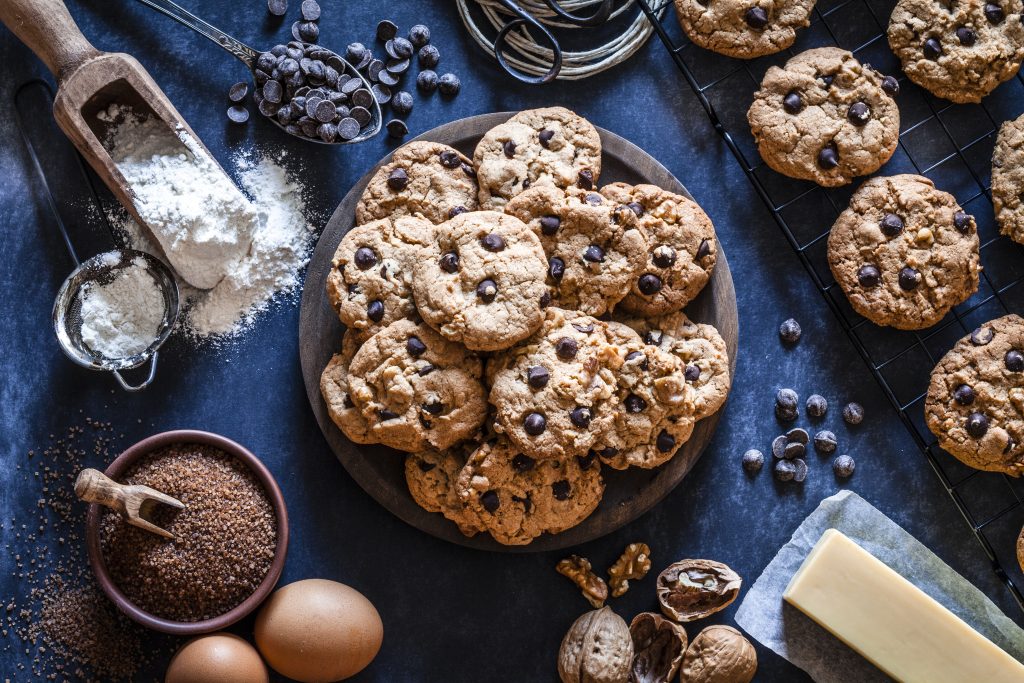
The fixings for a delicious batch of chocolate chip cookies
The Toll House Cookie
The modern-day version of the chocolate chip cookie first came to life in the mid-1930s. There was a popular inn in Whitman Massachusetts called the Toll House Inn that, at the time, specialized in home-style cooking. In an experimental cookie moment (and some say due to the fact that she ran out of nuts due to the Great Depression), Ruth Wakefield, one of the owners, added chopped-up bits of chocolate to her butterscotch cookies recipe. What came out of the oven was a legend unto itself. While some versions of this story describe it as a mistaken addition of chocolate, Wakefield clarified it was no accident. “We had been serving a thin butterscotch nut cookie with ice cream.” She said, “Everybody seemed to love it, but I was trying to give them something different. So I came up with (the) Toll House cookie.”
Ruth first published the recipe in her 1938 edition of Toll House Tried and True Recipes. The chocolate industry giant, Nestlé, took notice of her, and in 1939 Ruth sold the recipe to them. How much did she sell it for? A dollar and a lifetime supply of chocolate. Which might sound like a steal, depending on who you ask. Ruth is also credited with the invention of chocolate chips, as she was cutting up chocolate bars to make those chocolate morsels. To this day, Nestlé puts this same recipe on the back of their chocolate chip bags today!
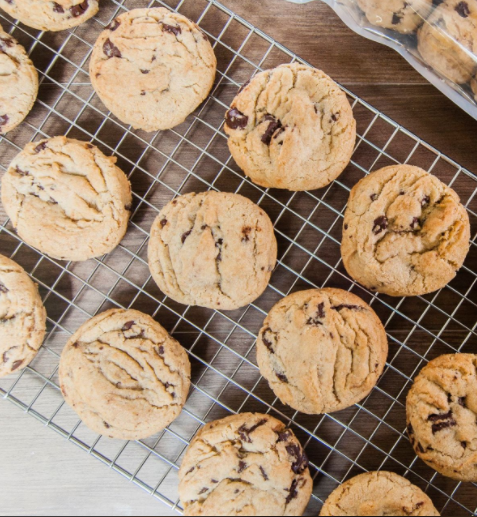
Freshly baked Chocolate Chip Cookies from the Sweet Valley Bake Shop
These delicious cookies caught on fast around the world. In 1956, they showed up in the UK under the name Maryland Cookies. And perhaps one of the most exciting chocolate chip innovations was in the mid-80s when Vermont’s Ben & Jerry’s had the bright idea to add chocolate chip cookie dough to their ice cream. The idea came from an anonymous public suggestion. It didn’t take long for this flavour to become a customer favourite. It actually kicked off the whole cookie dough phenomenon in ice cream.
It’s also worth noting that there have been some questions throughout the years as to who the first person to make chocolate chip cookies really was. It seems a bit odd that after two thousand years of people consuming chocolate, the chocolate chip cookie would be as young as it is. Although Ruth is without a doubt the inventor of the tollhouse recipe that still rocks the world to this day, she may not have been the first in history. Sor Andrea was a Dominican nun who is one of the people credited with inventing mole, an iconic Mexican purée of chili, spices, and sometimes cocoa. She became very interested in the healing benefits of cocoa and because it was mostly consumed as a beverage at this point, she attempted to make it in different forms. Records say that in 1679, she created something that was very similar to chocolate chip cookies! It’s difficult to say for sure if Sor Andreas was even the first, as these types of records do not always survive, however, it’s important to acknowledge it!
What Makes a Great Chocolate Chip Cookie?
There’s a lot that goes into making a perfect chocolate chip cookie. Like a magical potion (or a chemistry experiment) every ingredient plays its important part. Let’s look into what some of the major ingredients do and the factors that make them great.
Chocolate Type
There can be some mighty passionate debates about which chocolate type makes the best chocolate chip cookie. When it comes to whether it’s dark, milk, white, or ruby chocolate, opinion rules. Younger palates tend to prefer the more sugary chocolates like milk, white, or ruby. Whereas the complex flavours of 70% chocolate and higher are appealing to mature taste buds. Any of these choices are the right ones, so let your chocolate flag fly high!
To save money, many chocolate makers will reduce the amount of cocoa in favour of milk and oils. This will also reduce the quality of taste. There tends to be more oil or fat in chocolate chips as opposed to chocolate bars. Something has got to keep those chocolate chip tips pointy! To learn more about the differences in quality and varieties, you can read our type of chocolate blog where we go through it all in more detail.
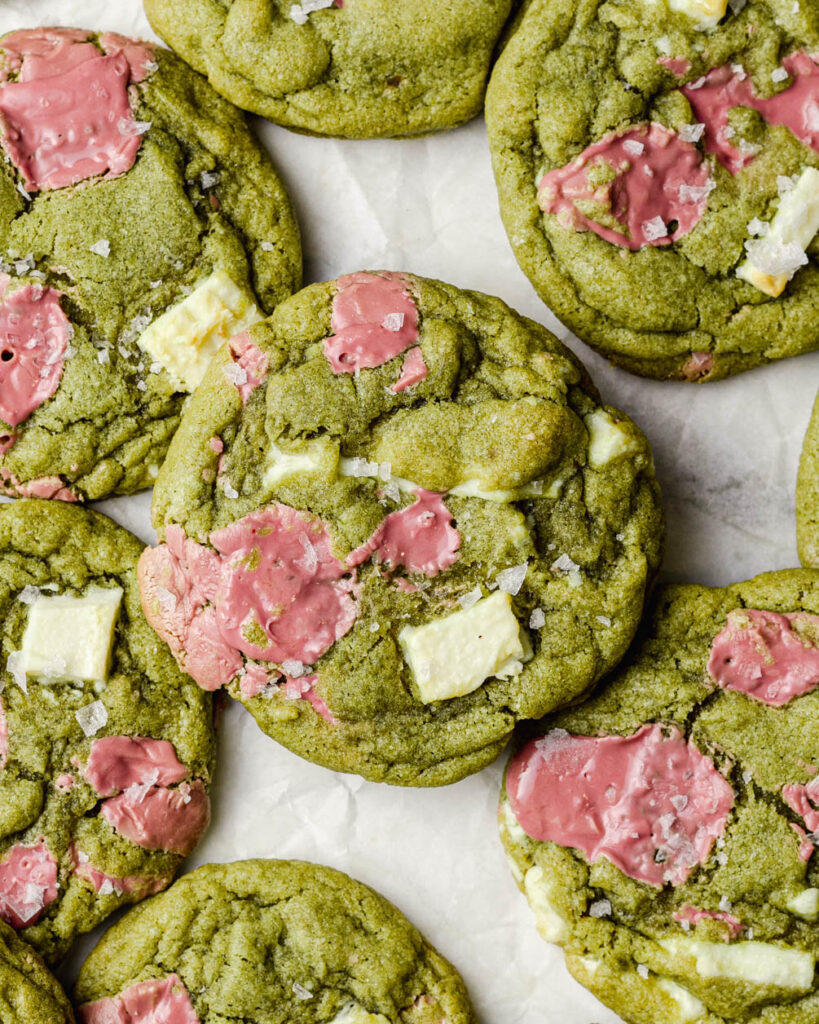
Ruby and white chocolate chunk matcha cookies (Halicopter Away)
Flour Type
In baking, flour provides structure to the cookies and can have one of the greatest effects on texture. When the flour’s ingredient ratio is off, it results in crumbly or wonky-shaped treats. One of the defining features of flour’s success is its protein content. The higher the protein, the more gluten, and the chewier the cookie. Although there’s no right or wrong answer to which type of flour is the best, most people like the all-purpose flour route. It makes a great cookie, its protein content sits at about a mid-range 10-12%, and the chewy ratio is satisfactory. It’s a great crowd-pleaser. However, there’s also the denser whole wheat flour that (whether for good or bad) some people describe as having a “healthier” taste.
Gluten free flour can be a lot of information to wrap your head around. There are so many options and different health benefits as well as so much history to them. We explore some of this in our gluten free flours blog if you’re curious about specific flours. There isn’t really one gluten free flour that gets the whole job done. Because of the gluten absence in these flours, there’s a noticeable lack of elasticity and/or structure. Your best bet is to go with a mix of flours and starches. That way, you get the structure of the flour with the elasticity of the starch. And your cookie is one happy camper.
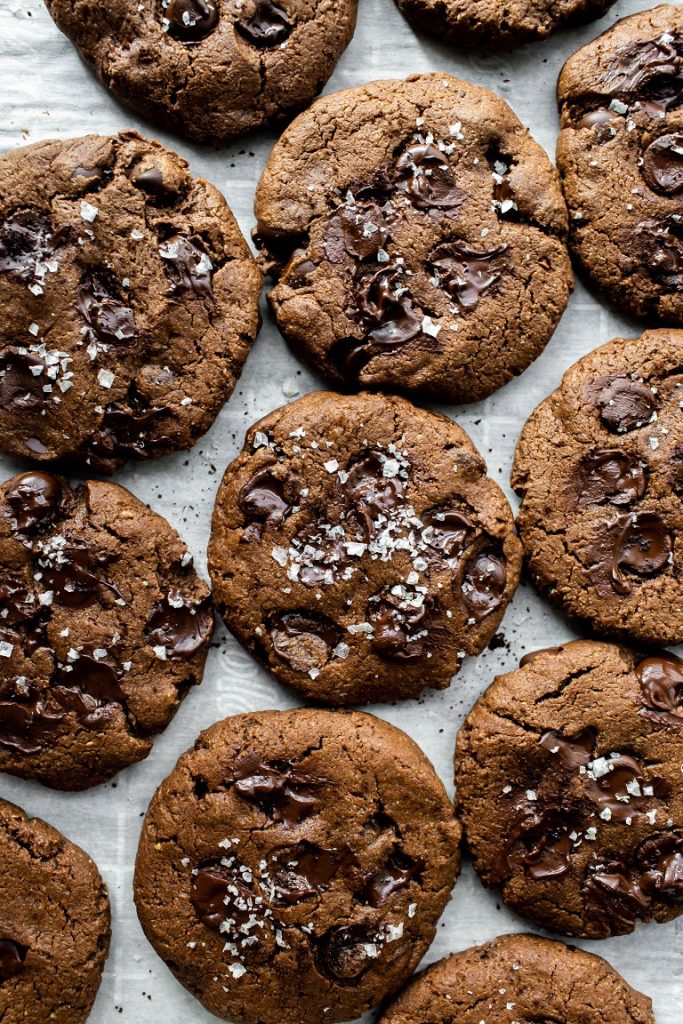
Gluten free espresso and sea salt chocolate chip cookies (The Vegan 8)
Sugar Type
When talking about sugars, there are two main routes to go down. One considers the granulated and brown sugar in that original Toll House cookie recipe. What are the roles of these two sugars? The role of sugar in the cookie-baking chemistry is wild, so we’ll keep it short and sweet (pun not intended, but very much appreciated). Sugar is a major player in the pH of a cookie and it helps determine the density as well. It’s also used as a preservative at times because of its ability to absorb water and reduce bacterial development. Brown sugar, with its molasses content, is more acidic than granulated sugar. So, it reacts with sodium bicarbonate (baking soda), creating an almost cakey texture in the cookie. White sugar doesn’t have this reaction, but it does affect the spreading of the cooked dough (depending on the other ingredients).
Another interesting factor is the option of using “natural” sugar. For example, coconut sugar is a very popular substitute for granulated sugar. Many people claim it’s a 1:1 ratio, but it certainly requires some fiddling around with the proper amount of fats and acids to get it right. As a general rule, if you add more fat, such as butter, it can help in creating a better taste immensely. There’s also the option of replacing the sugar with honey, agave, or – if you have access to it – maple syrup. This option is more tricky, as the baker needs to adjust the recipe for the added liquid. We are not sure that this effort will justify the health benefits, as these sugars have similar nutrient content to white sugar. There are so many factors to the reaction of sugars with ingredients like salt, butter, baking soda, etc., that you can’t definitively say what the outcome would be. That’s what makes it so interesting and such an important ingredient!
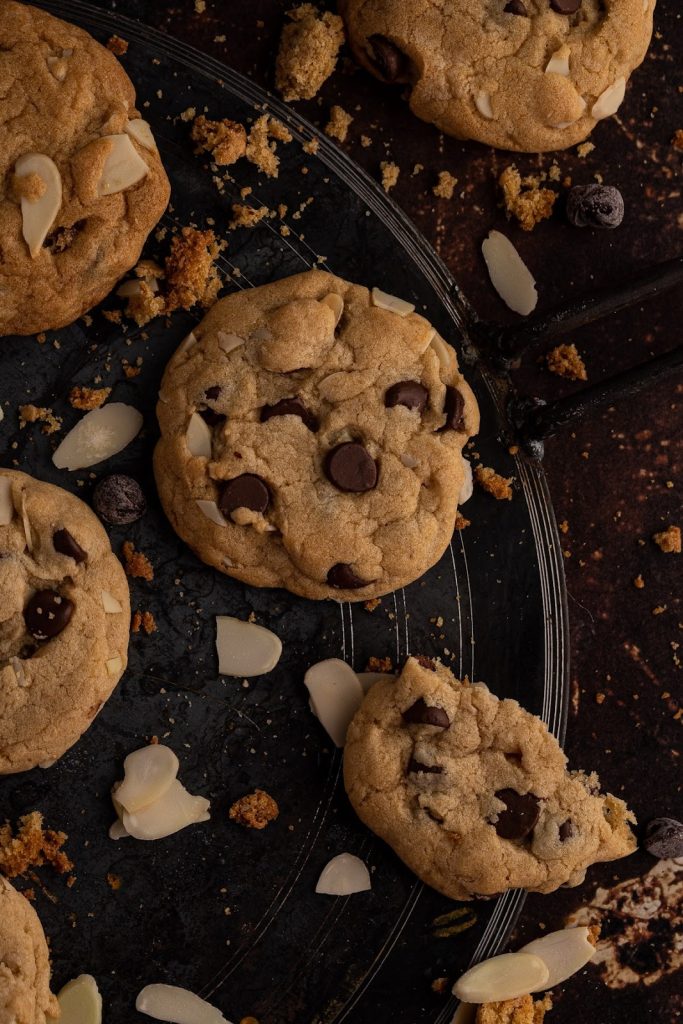
Maple syrup chocolate chip cookies (The Littlest Crumb)
Fat Type
The fat used in baking affects cookies in many interesting ways. One of them is how it interacts with gluten. When gluten is mixed with water, it becomes active and begins its process of giving elasticity and structure to the cookie. But it gets inhibited when there’s more fat, so, the resulting cookie is more tender. Fats also help with the distribution of heat throughout the cookie in the baking process, and they foster that perfectly-cooked golden brown glow.
Butter is the most popular fat type used in baking and it’s generally regarded as giving the best taste. There are three different ways you can add it to dough or batter:
- Cold butter has the highest water content of the three, at about 18%, so it doesn’t get fully incorporated into the dough. Mixing it in is what’s called “cutting it in,” and it creates a coarse, sand-like texture. So, the tiny pieces create a bit of steam in the baking process, which results in a flakey finished product. Cold butter is especially delicious for baked goods like pie crusts or scones.
- Melting the butter releases the water content to foster dense treats like brownies and loaves.
- Adding room-temperature butter means that the steam is distributed evenly throughout the dough or batter. Thus, it results in soft and gooey desserts like cakes or our special chocolate chip cookies.
Another type of fat is shortening, which was named after its chemical reaction with gluten – it shortens gluten bonds! Shortening is any fat that is solid at room temperature (although nowadays seldom refers to butter). It’s cheaper than butter, so it became very popular at one point in its lifetime. Actually, Ruth Wakefield herself used shortening in the original Toll House Cookie. It has a quieter taste, but the idea of hydrogenated vs. natural fats can make people less thrilled about using it. Margarine is similar to shortening in many ways. However, it does not contain milk content, so it’s one of the easiest to replace butter with in cookies.
Vegetable oils are perfect when used in desserts that require melted butter, but they require the balancing of other ingredients in a flakey pie crust or fluffy cookie recipe because they don’t have as much of the required steam reaction.
Lard is another fat that was completely replaced by shortening, but is making a bit of a comeback as of late. It’s the fat of a pig and reacts very similarly to butter in many recipes.

Edible cookie dough has a buttery texture and taste (Lifestyle of a Foodie)
Leavening Agent
The ingredient that leavens cookies is the one that creates a bubble-like reaction in the dough or batter. If you think about the children’s volcano science experiment with baking soda and vinegar, it’s like a smaller degree of that foaming happening in your cookies! There are many types of leavening agents, including yeast, barm, kefir, sourdough starter, and like we mentioned earlier, even steam and air! The most popular ones in treats like our chocolate chip cookies are baking soda and baking powder.
Baking soda is a crystalline solid that’s generally sold in powder form and reacts with an acid to help our baked goods rise. The leavening agent gets activated by the acid and then bubbles up, giving cookies their airy texture. Common baking acids are lemon juice, sour cream or yogurt, buttermilk, cocoa, vinegar, molasses, and in the case of our delicious cookies, brown sugar. Although the original Toll House Cookie recipe only had baking soda, many chocolate chip cookie recipes nowadays have replaced it with or added baking powder as well.
Baking powder is similar to baking soda, but it contains the required acid (e.g., cream of tartar) in it already. It also contains a buffer, like cornstarch to prevent the reaction from happening before we want it to. This consideration makes baking powder a great option for recipes that don’t have those acidic ingredients in them. A recipe containing both baking soda and baking powder usually occurs because the reaction with the acidic ingredient in the recipe wasn’t enough to create the texture the chef wanted. So, they can supplement baking powder to create the perfect fluffiness!
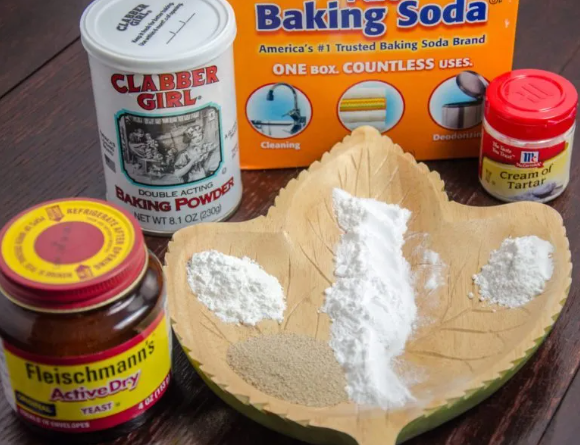
Different types of leaveners (The Housewife Modern)
Temperature
You may have noticed that when a baker plops down balls of cookie dough on a baking sheet, they’re much higher than the finished cookie circles we get to dip in milk and devour. When cookie dough enters the oven, it begins its metamorphosis by partially melting and spreading. Once it’s melted, it then starts to rise. The Maillard reaction (the reaction that creates the taste resulting from browned foods) then takes place and you know those cookies are cooked to perfection.
When cookies are baked at lower temperatures, the rising moment is delayed and they are able to spread out a bit more. Higher temperatures expedite the rising timeline and mean the spreading happens sooner. However, this isn’t just a matter of preference; there’s still a sweet spot you need to hit. If the temperature is too high, the cookie won’t cook evenly, it might be perfect on the inside, but too crispy on the bottom or edges. And if the temperature is too low, the cookie won’t rise properly or even at all. Unfortunately, the one and only perfect temperature for every cookie is only a thing of legend. It really depends on the recipe, it depends on the oven, and it will require a watchful eye and experimentation for the first batch. Once you find it, write it down! And it will make perfect cookies for you for the next time.
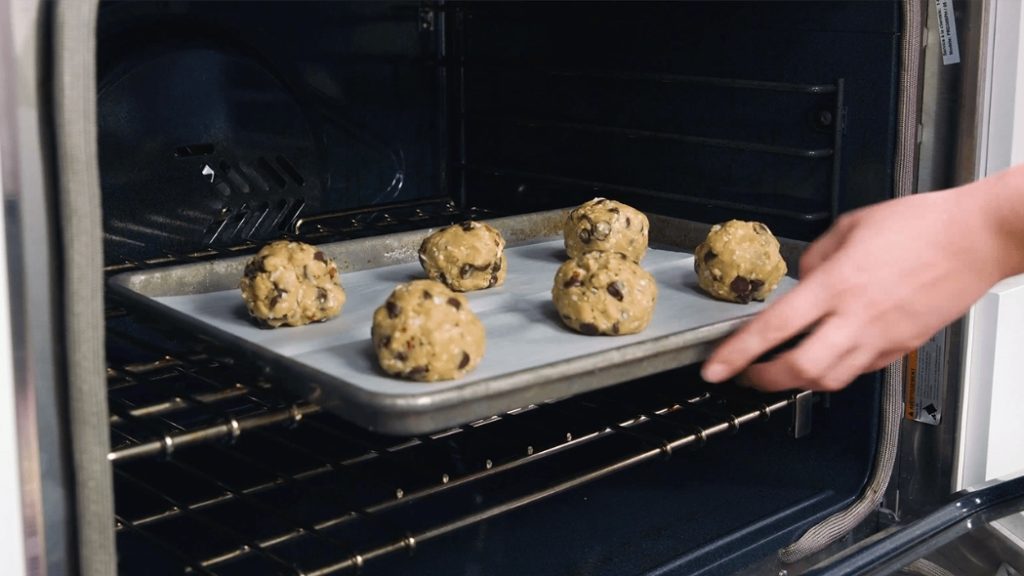
Cookies ready for baking (Stay-at-Home Chef)
Baking is truly an intricate science that can require years of study to fully understand. Most of us are just lucky enough to get to enjoy the spoils of it! If you are channeling some cookie monster energy after all this delicious chemistry exploration, our search tool can help expedite finding a chocolate chip cookie near you! Enjoy your cookies!




